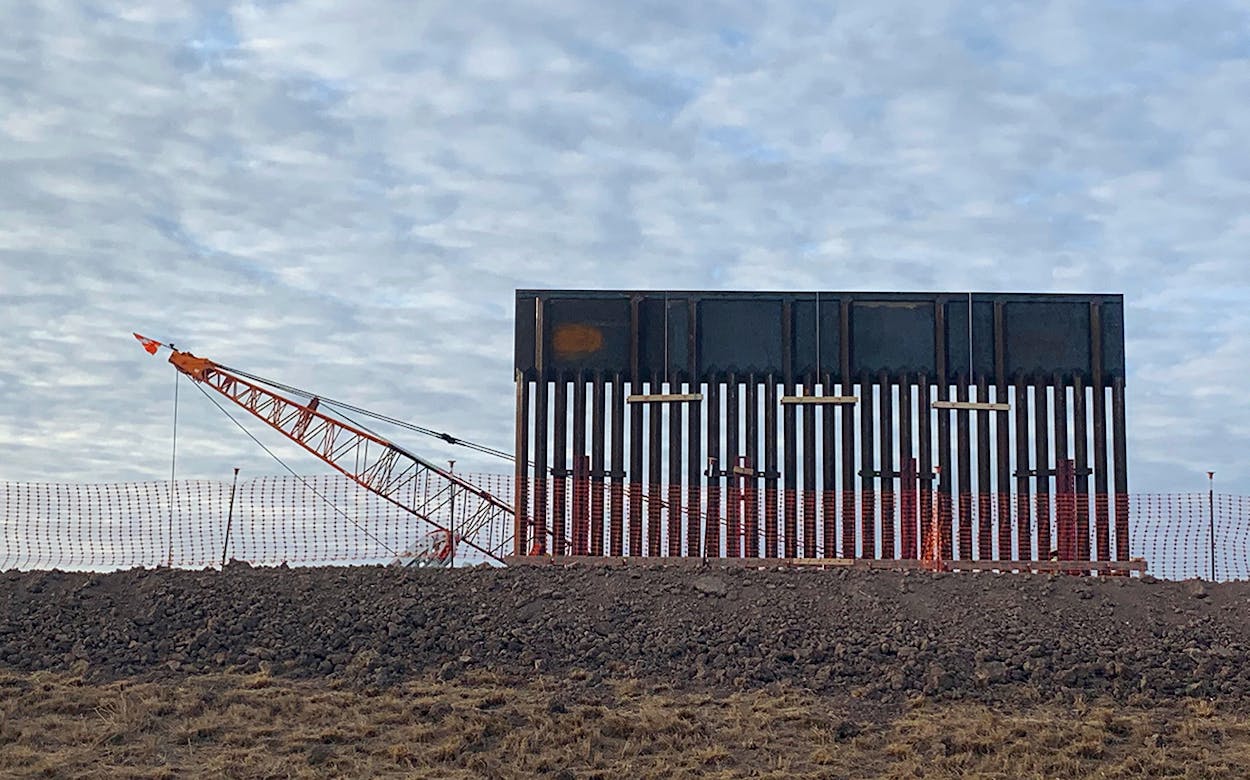This morning, things were busy at the site of a future border wall in South Texas. About two miles east of the Donna-Rio Bravo International Bridge, as trucks sprayed water on freshly graded dirt, roughly sixteen construction workers were busying themselves. A handful were working on a newly erected section of border wall, using a welding torch on the steel bollards that comprise it. About two weeks ago, two cranes and other heavy equipment started construction activity at the site, and rebar appeared to be staged along what’s planned to be a 150-feet enforcement zone—a clear-cut strip of land hosting a road, lights, and sensors—just south of where the wall is supposed to go.
At first glance, it looked like President Trump’s long-promised border wall—or at least a 30-foot section of it—has been built. Two immigration officials, neither of whom wanted to be identified because they were not authorized to speak for the agency, said the section went up Wednesday.
Last weekend, U.S. Customs and Border Protection tweeted images of heavy equipment working on or near the footprint of sections of border wall. “We’re building the border wall in South Texas in the busiest USBP sector,” the tweet stated.
We’re building the border wall in South Texas in the busiest USBP sector. This is in addition to the 75 miles of new border wall system already built. This new capability is exactly what the frontline men and women need and have asked for. #BorderSecurity pic.twitter.com/GuGgnjXZ6i
— CBP (@CBP) October 27, 2019
But it’s not quite so simple.
Like much of the 65 miles along which Congress has authorized building barriers through the Rio Grande Valley, the mile-long segment between the Donna and Progreso international bridges involves much more than just a wall. Right now, there’s a modest earthen levee, owned and operated by the International Water and Boundary Commission, built for flood control purposes. The Trump administration plans to replace this levee with what’s been termed a levee wall, a concrete levee topped by an eighteen-foot-tall bollard-style fence. But I saw no evidence that any of the concrete work has begun. I was unable to view the base of the wall segment because it was hidden behind the earthen levee. Were the bollards cemented in the ground, or was the structure just being assembled on-site to later be installed atop the concrete levee?
There’s also the matter of land ownership. Last week the Washington Post reported that federal officials have acquired only 16 percent of the private land needed in Texas for its proposed border wall route. It wasn’t immediately clear whether the federal government owned the land in question in Donna. Hidalgo Appraisal District maps were not immediately clear about current ownership at this site. The Post also reported that smuggling gangs in the San Diego area have begun cutting through sections of wall there using commercially available power tools.
Some Valley activists believe that much of what’s going on is simply political theater. Scott Nicol, co-chairman of the Sierra Club Borderlands Campaign, told me on Friday, “It looks like they are trying to throw something up quickly so they can demonstrate to President Trump that there’s action. But this is not part of any rational (construction) strategy. They’re not going to be able to build a whole lot more in the short term because they don’t own the land.”
Contracts have already been awarded for the sixty-five miles of wall construction in the Rio Grande Valley, at a total estimated cost of between $400 million and $800 million.
- More About:
- Border Wall






